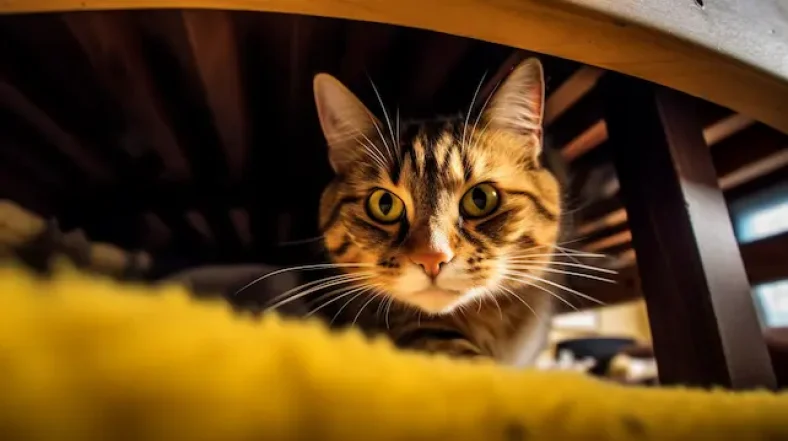While it might seem like a fun game when your kitty sneaks under the bed, it’s not always the best idea. There are a few reasons why letting your furry friend explore under there all the time may not be the best for them.
Keeping cats from going under the bed can be challenging. Not only is it hard to get them out when you need to, but they can also cause damage to the bottom of the bed and potentially get stuck or hurt.
There are ways to prevent your cat from going under the bed altogether while still allowing them to have their own private space.
Let’s explore why cats like hiding under beds, how you can block off access to that area, and some other tips for keeping your feline friend happy and healthy.
Key Takeaways
- Hiding behavior in cats can be a sign of underlying issues and can lead to aggression or destructive behavior.
- Providing alternative hiding spots and addressing the root cause of anxiety or stress can discourage the behavior.
- Preventing cats from going under the bed is important for safety, hygiene, damage, sleep quality, and allergies and can be achieved by using bed blockers and creating alternate hiding spots.
- Consistency is key when trying to break unwanted behavior in cats and addressing hiding behavior can strengthen the bond between a cat and its owner.
Contents
Why you shouldn’t let your cat hide under the bed
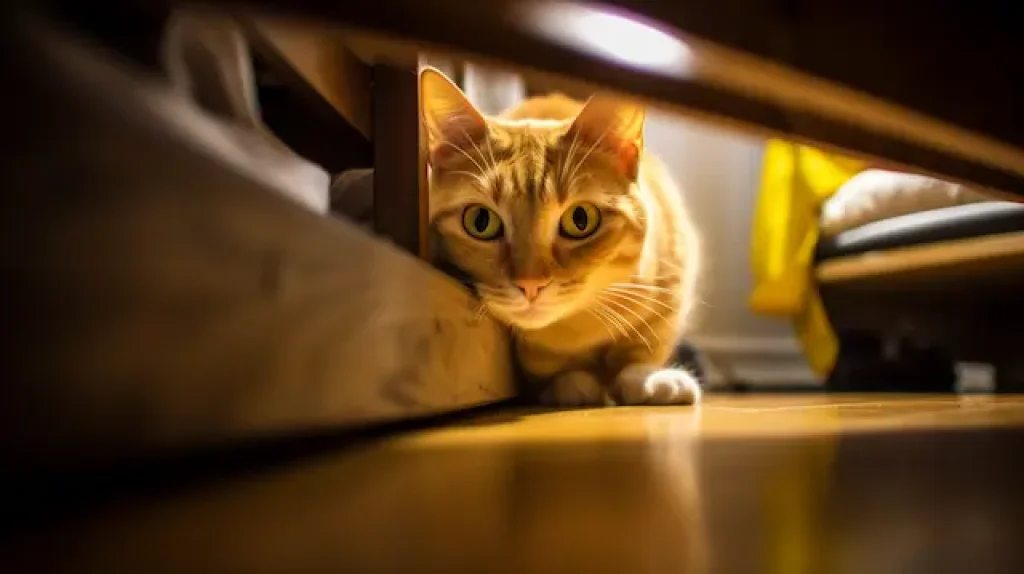
For one, your cat could get stuck or trapped in a tight space, leading to injury or distress.
Allowing your cat to constantly retreat under the bed can have a negative impact on their well-being and socialization skills.
Potential dangers and risks
Unfortunately, if your cat continues to hide under the bed, there’s a 50% chance they’ll encounter dust mites and other harmful allergens that could affect their health.
In addition to these potential health risks, there are also other dangers that your cat may face when hiding under the bed.
Physical Dangers
- Your cat may accidentally get trapped or stuck under the bed and not be able to get out
- There’s a risk of injury if your cat tries to jump onto or off of the bed while underneath it
Behavioral Dangers
- Allowing your cat easy access under the bed can reinforce negative behaviors such as hiding or avoiding interaction
- If you have a new cat in the house, both the new cat and the resident cat may feel intimidated by each other, especially if the resident cat frequently hides under the bed, which could potentially lead to aggression between them
It’s important to recognize these risks and take steps to prevent your cat from going under the bed.
Negative impact on your cat’s well-being
Hiding under the bed can take a toll on your furry friend’s happiness and health. Your cat may feel anxious or stressed when they’re unable to come out from under the bed, leading to behavioral issues such as aggression or avoidance.
If your cat spends too much time hiding under the bed, they may become overweight due to lack of exercise. To keep your cat happy and healthy, it’s important to stop them from going under the bed.
Why cats hide under beds
There are various reasons behind this behavior.
Cats may hide under the bed due to anxiety or stress, as it provides them with a sense of comfort and security.
They might be seeking a cozy and quiet place for sleep and relaxation.
Hiding under the bed could also indicate possible health issues that need attention.
Anxiety or stress
When you’re feeling anxious or stressed, your cat may sense it and seek comfort by hiding under the bed. This is because cats are highly sensitive to their environment and can pick up on changes in your behavior or mood.
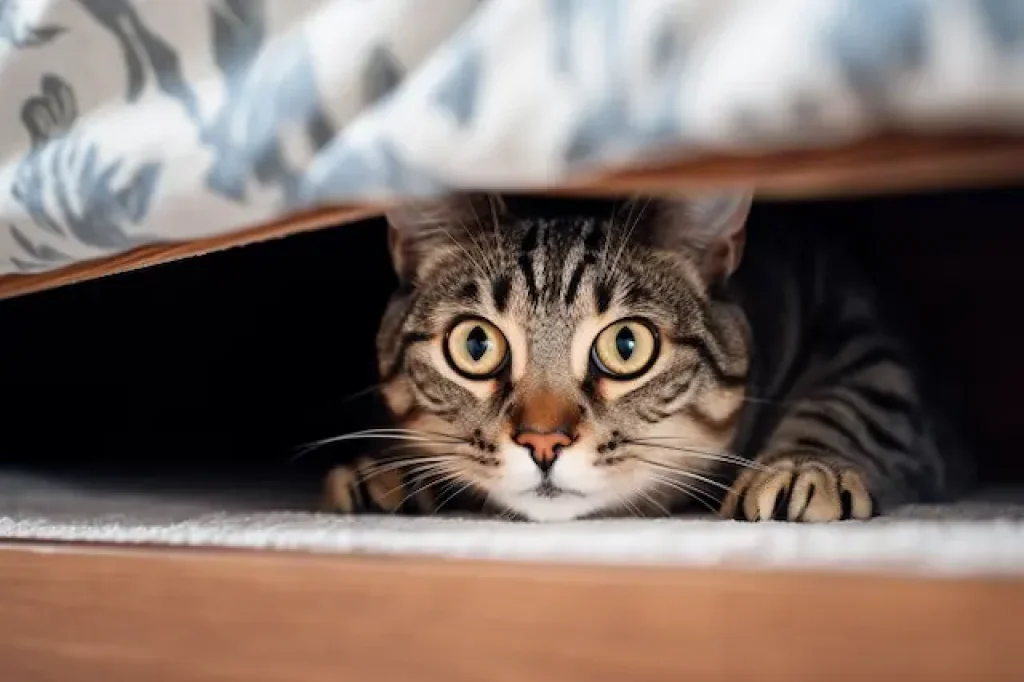
To stop your cat from going under the bed due to anxiety or stress, you need to help your cat feel more secure and comfortable. One way to make your cat feel more at ease is by providing a safe space for them to retreat to when feeling overwhelmed.
This could be a cozy bed, a quiet room, or even a cardboard box with a soft blanket inside.
Additionally, playtime and exercise can help reduce your cat’s stress levels and increase their confidence.
Need for sleep and relaxation
Sometimes, you just need to take a break and relax, and your furry friend is no exception. Cats are known for their love of sleep and relaxation, which is why they tend to hide in cozy spaces like the space beneath your bed.
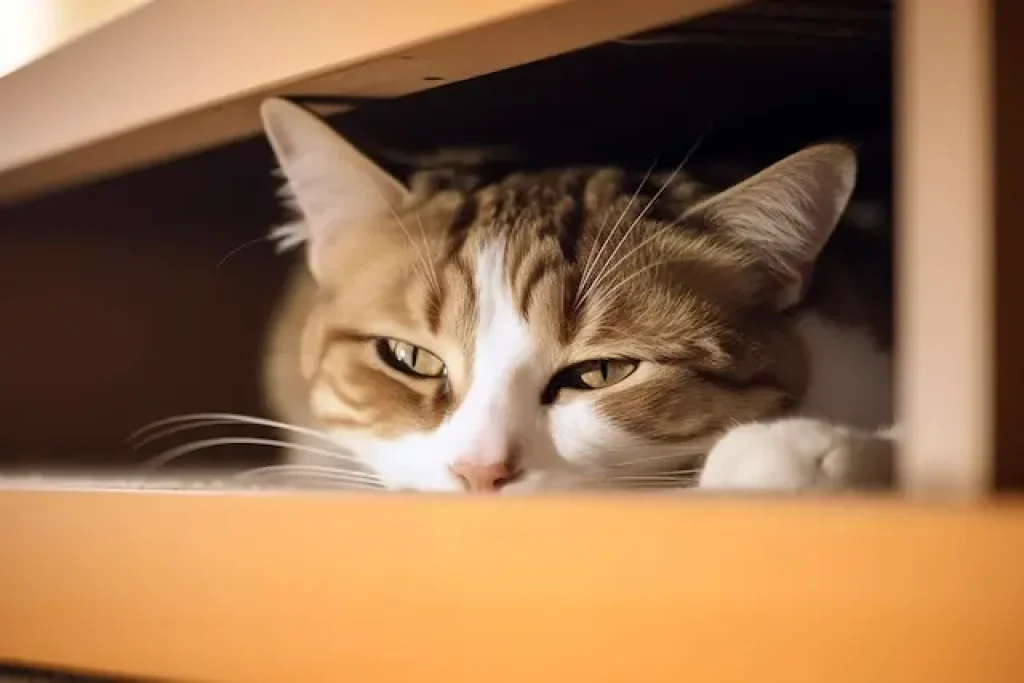
While it’s important to make sure your cat isn’t hiding due to anxiety or stress, sometimes they just need some alone time.
If you’re trying to stop your cat from going under the bed, consider providing other cozy spots for them to relax in.
Bed blockers for cats can be a great solution if you don’t want your feline friend hiding under the bed all the time. These are essentially barriers that prevent cats from getting underneath furniture, while still allowing them enough space to move around comfortably.
However, it’s important to remember that cats’ hiding behavior is natural and can provide them with a sense of security.
So don’t be too quick to completely eliminate areas where your cat can hide – instead, try finding a balance between providing alternative relaxation spots and letting your cat have some privacy when needed.
Seeking safety and security
Not only is it difficult to reach them when they’re hiding in such a small space, but it can also lead to health issues if they stay there for too long.
To stop your cat from going under the bed, you need to understand why they like that area so much. Cats are natural hunters and love to hide in small spaces as this gives them a sense of security. They may also be seeking some peace and quiet away from any distractions or noise in the house.
To give your cat what they’re looking for without compromising their safety, try providing them with other cozy spots around the house that mimic the feeling of being under the bed. This could include a covered cat bed or even a cardboard box placed in a secluded corner of the room.
Possible health issues
You may not realize it, but allowing your furry friend to hide under the bed for extended periods could potentially lead to health issues. Here are some possible reasons why and what you can do to prevent them:
- Lack of exercise: If your cat is constantly hiding under the bed, they might not be getting enough exercise. Encourage them to play with interactive toys or take them on regular walks around the house.
- Poor posture: When your cat is crouched under the bed, their spine and neck are in an unnatural position, which could lead to discomfort or even injury.
- Increased stress: If your cat is constantly hiding, it might indicate that they’re feeling stressed or anxious about something in their environment.
It’s also important to address any underlying stressors in their environment and make sure their litter box and food/water bowls are easily accessible.
Remember that while it’s natural for a new cat to hide for safety reasons at first, prolonged hiding could be an indication of potential health issues that should be addressed with a veterinarian.
How to keep cats from going under the bed
Before implementing any of these methods, it’s important to rule out any health-related reasons causing your cat to seek refuge under the bed. Visit a vet for an evaluation to ensure your pet isn’t hiding due to discomfort or pain.

Identifying and eliminating stressors
Identifying and eliminating stressors in your home environment can greatly reduce the likelihood of your furry friend seeking refuge under the bed. Cats living in multi-cat households are more likely to experience stress and anxiety.
Here are four ways to identify and eliminate stressors for your cat:
- Create a safe space: Cats need a quiet place where they can retreat when feeling overwhelmed or stressed. Make sure there’s at least one room in your house where your cat can go to feel safe and secure.
- Provide vertical space: Cats like to climb and perch up high, so providing some tall cat trees or shelves can help them feel more comfortable in their environment.
- Control noise levels: Loud noises such as music, vacuum cleaners, or even construction noise can be very stressful for cats. Try to keep these noises to a minimum or provide white noise machines if necessary.
- Reduce competition: If you have multiple cats, make sure they each have their own food bowl, litter box, and toys so they don’t have to compete with each other for resources. This will reduce stress and create a more peaceful environment for all of them.
Remember that every cat is different, so it may take some trial and error before finding what works best for yours!
Offer alternative hiding spots
Add cozy hiding spots, like a covered cat bed or a cardboard box with a hole cut out, to give your furry friend more options for feeling secure and comfortable.
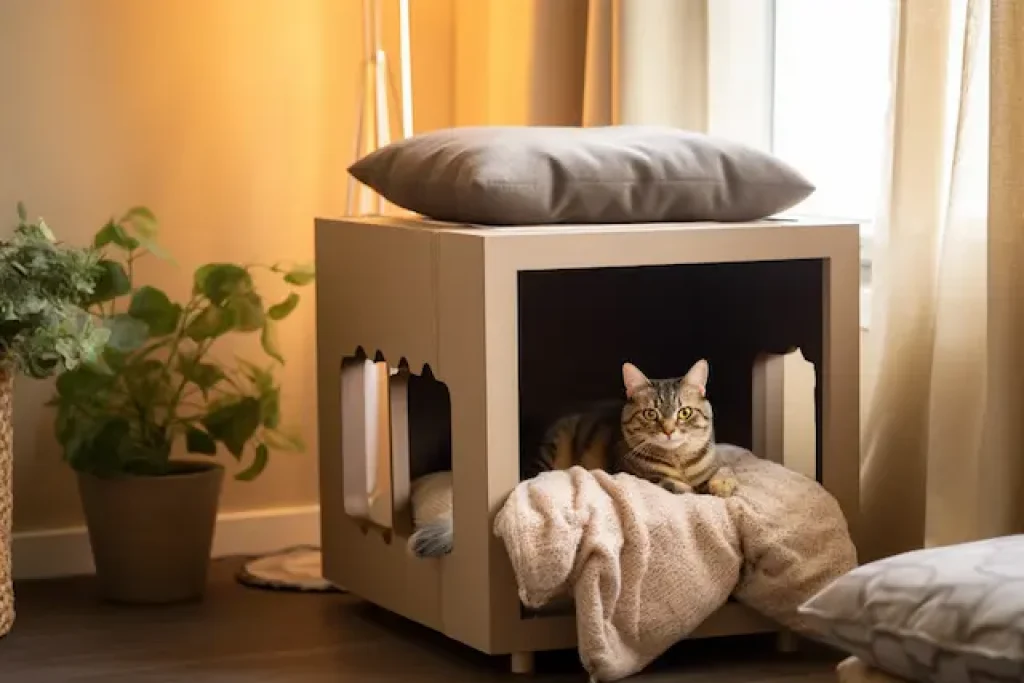
Here are some tips on how to create a cat-friendly environment:
- Provide multiple scratching posts in various locations around your home.
- Place catnip or treats near their alternate hiding spots as an added incentive for them to explore new areas.
Using under bed cat blockers
Try using under bed cat blockers to create a safer and more comfortable environment for your cat. These blockers are designed to prevent the cat from going under the bed without blocking off the entire area.
Here are some ideas on how you can use under bed cat blockers to stop your cat from going under the bed:
- Purchase commercially available under bed cat blockers in various sizes and materials.
- Use sturdy cardboard boxes or storage containers that fit snugly underneath the bed frame.
- Another option is to use foam pool noodles or pipe insulation cut to size and placed underneath the edges of your mattress. This’ll create an obstacle that’ll deter your kitty from going underneath.
By using these simple yet effective solutions, you can provide a safe space for your furry friend while also keeping them away from potential hazards under the bed. So give it a try and see if these under bed cat blockers work for you!
Implementing bedroom restrictions
If you want to keep your bedroom a cat-free zone, it’s important to establish clear boundaries and stick to them. One effective way to do this is by implementing bedroom restrictions.
This means that you’ll need to train your cat not to enter your bedroom by closing the door or using a baby gate.
However, if you want to allow your cat in the bedroom but prevent them from going under the bed, use DIY under bed blockers such as cardboard boxes or storage containers.
This will prevent your cat from hiding under the bed and potentially damaging items stored there while still allowing them to stay close by and feel secure.
DIY under bed blockers for cats
With a little DIY ingenuity, you can easily create under bed blockers that will keep your feline friend at bay.
In this section, we’ll explore some simple and effective solutions for keeping cats out from under the bed using materials you may already have at home.
DIY under bed shelf
Create a DIY under bed shelf to not only solve your cat hiding problem, but also add extra storage space for your belongings.
If your cat is hiding or going under your bed, this solution can provide a designated area for them to relax and feel comfortable while still being close by.
To make the shelf, measure the dimensions of the space underneath your bed and cut a piece of wood or plywood to fit as the base of the shelf. Then attach wooden planks or brackets on each side to act as supports for the shelf.
Finally, slide the shelf in place underneath your bed and let your cat explore their new cozy spot! You can also use this extra storage space for items such as shoes, clothing, or books.
Allowing your cat their own special spot will give them a sense of security and keep them from constantly hiding underneath your bed.
DIY Foam Board/cardboard under-bed blocker
Using foam board or cardboard to block the space underneath your bed can provide a simple and effective solution for keeping unwanted items from accumulating in that area. If your cat’s been going under the bed, this DIY blocker can also help prevent them from doing so.
Simply measure the length and width of the bed gap, cut out pieces of foam board or cardboard to fit, and slide them into place. You may need to secure them with tape or glue to ensure they don’t shift around.
This inexpensive and easy fix can give you peace of mind knowing that your cat won’t be hiding under the bed anymore.
DIY Plexiglass Under-Bed Blocker
Now that you’ve tried the DIY foam board/cardboard under-bed blocker and it didn’t work, it’s time to move on to another solution to keep your cat from hiding under your bed.
One effective way to stop your cat from going under the bed is by creating a DIY plexiglass under-bed blocker. This will help seal off the space beneath your bed, making it less enticing for your feline friend to hide in.
With just a few materials and some basic tools, you can easily create a customized barrier that fits perfectly under your bed frame and keeps your cat from hiding where they’re not supposed to be.
DIY Bed Skirt with Velcro
To easily cover the space under your bed, why not try making a DIY bed skirt with velcro that sticks to the frame like peanut butter to jelly?
This is a great way to prevent your cat from going under the bed and hiding out of reach.
All you need are some fabric, scissors, velcro tape, and a sewing machine or needle and thread.
Measure the distance between the floor and the bottom of your bed frame, then cut your fabric accordingly.
Sew on the velcro tape along both sides of each panel of fabric, then attach it to your bed frame.
Not only will this stop your cat from hiding under the bed, but it also adds an aesthetic touch to your room.
Plus, it’s a fun DIY project that you can complete in no time!
Common mistakes to avoid
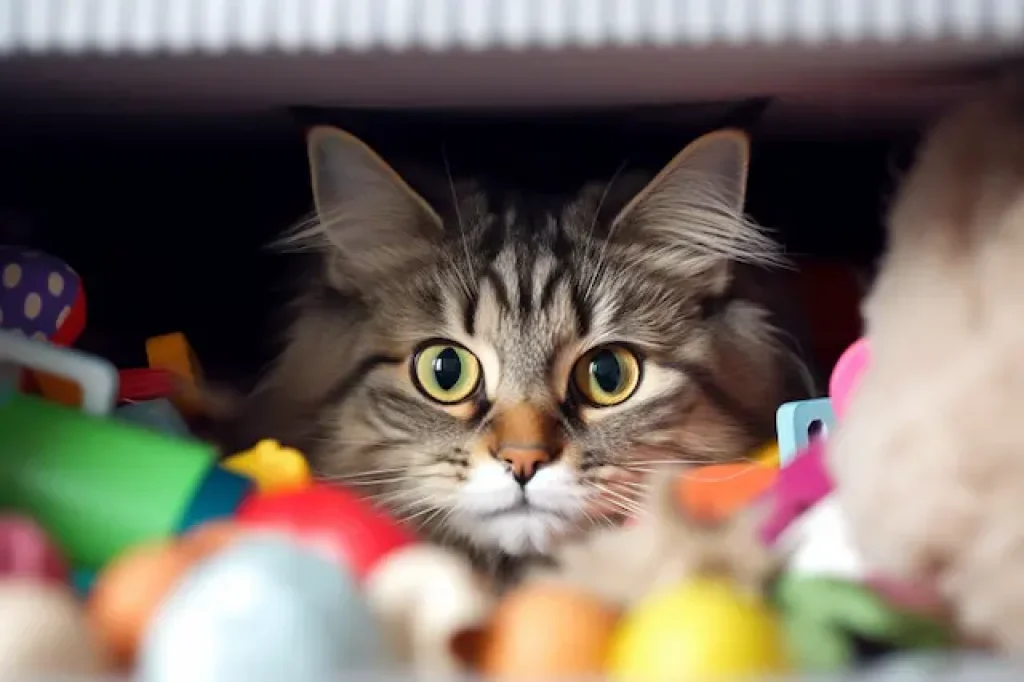
Avoiding common mistakes can be the key to successfully keeping your cat from going under the bed. Cats love hiding places, and they see under the bed as an ideal spot for their afternoon nap or just to get away from it all.
However, if you want to avoid having your cat constantly going under the bed, there are a few things you should avoid doing.
- Never force your cat out from under the bed by pulling its tail or dragging it out. This can cause physical harm to your pet and make them scared of you in future.
- Don’t block off access to the area underneath with heavy objects like boxes or furniture. Not only could this hurt your cat if they try to move them aside but also create other hiding spots around the house which may become more dangerous than simply being under the bed.
- Don’t ignore signals that indicate something is wrong with your feline friend such as changes in behavior or appetite since these could indicate health issues that need addressing before they start using hiding places more often.
Instead of making these common mistakes when trying to keep your cat from going under the bed, try some alternative solutions instead.
Encourage playtime and interaction with toys upstairs so that they associate being up above ground level with fun times rather than just sleeping alone down low all day long!
You could also provide a cozy little hideaway elsewhere in your home where they feel safe and comfortable whenever they want some alone time without needing access underneath furniture at all times – perhaps invest in a small tent-like structure for them?
Lastly, but not least importantly: always make sure that there’s plenty of fresh water available at all times too!
FAQs
Can I train my cat to stop hiding under the bed?
Yes, you can train your cat to avoid hiding under the bed by providing alternative hiding spots or play areas. Reward them when they choose these spots and discourage access to under the bed by blocking it off or using deterrents.
Are there any health concerns associated with cats hiding under the bed?
Yes, there are potential health concerns associated with cats hiding under the bed. They can accumulate dust and allergens which may cause respiratory issues. Additionally, they may become stuck or injured in tight spaces.
Should I be worried if my cat only hides under the bed and not in other places?
Don’t worry if your cat only hides under the bed. It’s a common place for them to seek refuge and feel safe. As long as they come out to eat, drink, and use the litter box, they are probably just fine.
Will blocking off access under the bed affect my cat’s behavior or mood?
Blocking off access to under the bed may make your cat feel anxious or stressed. It’s important to provide alternative hiding spots and enrich their environment with toys and scratching posts. Consider consulting a vet or behaviorist for further advice.
What if my cat still insists on going under the bed despite my efforts?
If your cat still insists on going under the bed despite your efforts, try providing an alternative hiding spot or creating a cozy area in a different location. Positive reinforcement can also encourage your cat to stay out of forbidden areas.
Conclusion
Congratulations! You’ve successfully learned how to stop your feline friend from hiding under the bed. By understanding why cats hide under beds and blocking off access, you can create a safer and happier environment for your pet.
But, remember, this isn’t just about stopping your cat from going under the bed. It’s about creating a warm and loving home for them to feel safe in. Your cat is more than just a pet; they’re a symbol of love and companionship in your life.
So, take care of them as you would any other family member, because they deserve it.
In the end, it’s up to you to make sure that your furry friend feels secure and comfortable in their surroundings. With these tips and tricks, you can ensure that your cat always has a place to call home – even if it’s not under the bed.

